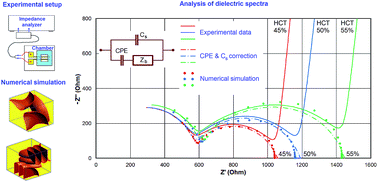Electrochemical impedance spectroscopy of blood. Part 2: numerical analysis of experimental dielectric spectra using the biconcave shape of human erythrocytes
Abstract
Results reported in the companion paper (Zhbanov and Yang, Anal. Methods, 2017, 17, 3302) showed that electrochemical impedance spectroscopy is a highly promising tool for the analysis of blood. In this study, dielectric spectra of human blood at various hematocrits were measured by using a two-electrode system in the frequency range from 40 Hz to 110 MHz. A numerical technique based on a finite difference method has been improved to calculate the effective complex permittivity of blood. Various models of erythrocyte shapes such as spherical, cylindrical, disk-shaped, spheroidal, and biconcave shapes were investigated. The numerical calculations showed that the cylindrical, disk-shaped, and biconcave models give comparable results, which differ significantly from those of the other models. Additionally, the effective complex permittivity of blood was analytically calculated based on the effective medium theory where erythrocytes are modeled as a conducting spheroid surrounded by a thin insulating membrane. The analytical calculation qualitatively reproduces the behavior of the dielectric spectrum, but quantitatively differs from the numerical simulation. The dielectric properties of erythrocyte cytoplasm and membranes were numerically determined based on the experimental data. Numerical analysis of the dielectric spectra of blood samples confirmed β-relaxation at frequencies between 100 kHz and 10 MHz and δ-relaxation in the frequency domain from 10 MHz to 1 GHz. The time-dependent changes in blood conductivity were measured during erythrocyte sedimentation. The measured blood conductivity increased slightly during the first minute and decreased within a few hours. This increase is attributed to the aggregation of erythrocytes. The numerical simulations confirmed that the blood conductivity increases to the maximum and then decreases slightly with growing aggregate size.



 Please wait while we load your content...
Please wait while we load your content...